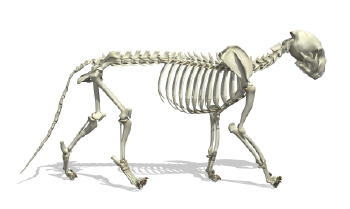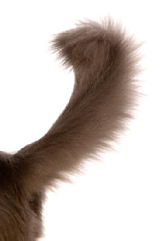Cat Spine...spinal integrity of the cats back

Coty playing acrobat cat on the door

Cat spine ...the best explanation of cat care for the building blocks of the back. The feline spine is a marvel of engineering resembling a small suspension bridge, cradling an information superhighway. The feline spine not only supports the body's architecture but also protects the spinal cord ...the thick nerve cable that connects the brain to peripheral nerves throughout the cat's body. The spine is also flexible, which you know if you've ever watched your cat fold herself into a small nook.
The feline backbone consists of over thirty-three bony vertebrae, divided among five categories. Seven cervical vertebrae comprise the neck, thirteen thoracic vertebrae connect to ribs in the chest, seven lumbar vertebrae make up the lower back, three sacral vertebrae connect to the hip bones, and anywhere from three to twenty-eight caudal vertebrae lie within the tail.
The joints between vertebrae are of two kinds: inter-vertebral disks ...fibrous elastic cushions between each vertebra; and articular joints ...tiny, curved facets of bone that contact a complementary socket in the neighboring vertebra.
The two articular joints on each vertebra only allow movement in certain directions, thus stabilizing the back. If you observe your cat playing with a toy, you may notice she can easily curve her neck from side to side to track it, but her neck stays almost straight when she looks up or down.
Her lower back, on the other hand, can arch up or flatten out as she pounces and runs, but doesn't curve much from side to side. This is because the orientation of the articular joints changes in different regions of the back. Thus, cats have flexibility where they need it without compromising the strength of the back as a whole, keeping the cats health more stable. The cat spine is remarkable.
In the cat spine each vertebra has a round opening between the upper vertebral process and the lower vertebral body, which allows for the passage of the spinal cord. At regular intervals along its length, the spinal cord sprouts pairs of spiral nerves, which branch off to the left and right of the vertebral column.
These spinal nerves receive messages from all corners of the body about sensations, muscle activity, and the state of various organs. They also send messages such as ...move left leg forward...or...find a litter box now.
Cats rely heavily on agility and flexibility for survival. Cats rarely develop signs of spinal disease. By far the most common back problem of cats is trauma...usually caused by a car or a fall. Injured cats may suffer fractured vertebrae, vertebral dislocation (luxaction), inter-vertebral disk extrusions, and spinal-cord bruising. When the injuries are severe, there isn't much a vet can do, but in milder cases, a veterinary surgeon may be able to repair the damage.
The dominant gene that produces taillessness in Manx cats can also cause spina bifida...the failure of the vertebrae in the lower back to close over the spinal cord. Cats with spina bifida may also have nerve-cord malformations that lead to bladder and bowel-control difficulties and back leg weakness. These problems occur more often in "rumpy" Manxes...those with no discernible tail vertebrae...rather than in "stumpy" Manxes with a very short appendage.
One of the more common injuries of a cat spine occurs when a cat's tail is caught by a moving car or a shutting door. The trapped animal instinctively pulls away, often separating the vertebrae at the root of its tail and damaging its spinal cord or cauda equina ("horse tail") ...the multiple nerve fibers that exit the base of the spinal cord. This injury often leads to tail paralysis and elimination difficulties, but if the damage isn't extreme, the nerves may heal and regain function. Diligent cat care is needed.
Tumors are the second biggest threat to the cat spine. If a tumor lies outside the spinal cord (extramedullary), surgery may eliminate it, but tumors within the spinal cord (intracedullary) are usually inoperable...although they may respond to other forms of therapy.
The most common feline spinal tumor is extramedullary spinal lymphoma. Cats infected with the feline leukemia virus (FeLv) are especially prone to this type of tumor. When a tumor begins pressing on the spinal cord, the first sign is usually loss of proprioception which is the ability to know where your limbs are in space. Getting drunk in the back end is usually what it looks like. If the spinal compression continues, it can cause weakness, loss of sensation, pain and paralysis.
If your cat staggers, limps, appears to be in pain, or doesn't seem to have proper use of her tail or a limb, immediately take her to your vet. By examining your cat and observing her movements, the vet may be able to assess the likelihood of a spinal problem and determine its location.
Weakness or paralysis of only the hind legs or tail
suggest a spinal injury in the lower back. If both the front and back
legs are affected, the injury probably lies in the brain, cervical
spine, or high thoracic spine. Signs that are asymmetrical, such as a
limp on one side, may indicate a tumor pressing on one side of the
spinal cord.
To find the cause of a cat spine injury, a
vet will usually recommend an x-ray of the cat spine. But since most
tumors and other soft-tissue injuries don't show up on x-rays, the vet
may need to do further tests, such as a bone-marrow biopsy (if lymphoma
is suspected) or a myelogram ...an injection of dye into the
spinal canal followed by an x-ray. If your vet has access to MRI
(magnetic resonance imaging)equipment, he may also recommend this test.
Keep in mind that signs like lack of coordination and limping don't necessarily indicate a spinal injury. Many other ailments including muscle pulls, infections, and inner ear problems, can cause similar signs. Since there is no way of knowing for sure, take your cat to the vet at the first sign of a false step.
Related Articles......
Return from Cat Spine to Cat Health Homepage
Having trouble finding what you need? Cat Health Index & Site Map
OR
Do you have a question to ask?...Questions
OR
Do you have a cat story to share?...Simply click here to go to that page!
Copyright@2010-2020 All rights reserved.Cat-health-detective.com
This website is information only. Consult a veterinarian for medical assistance

"Like Us" on Facebook
or...
"Like Us" here




















